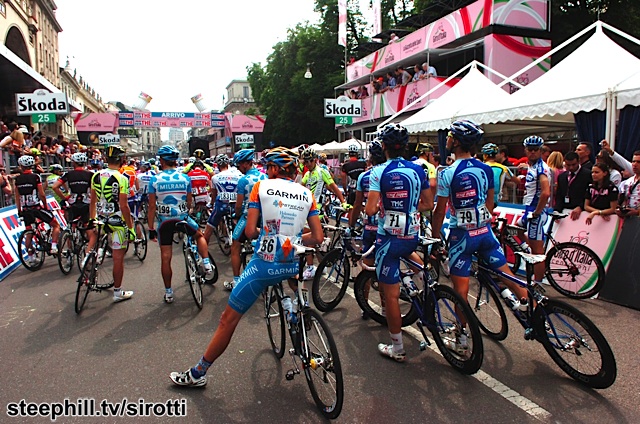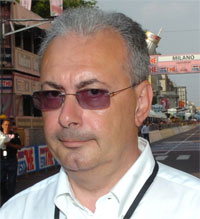|
|
Cycling Italy
|
 |
Stage |
Post Stage Analysis
Post Stage 9 Analysis: Polemica! Milano Circuit Neutralized
Cavendish wins in Milano after riders refuse to race

Sciopero! (Midrace Strike)
May 17 update: It was a day of polemica at the Giro as the riders refused to race, protesting the danger of the Milano circuit and the risks of the previous stages. The race organizers agreed before the start of the day to neutralize the stage for the general classification riders. But leading riders in the Giro field decided this was not enough, and on the road, they agreed not to contest the stage until the final kilometers.
Race leader Danilo Diluca announced the decision, stopping the race a few laps after the start. "We ask for the understanding of the public, but today, we do not want to take any risks, because the circuit is too dangerous. We will continue the stage, but we are not going to push at all." Julie Macur of the New York Times reported via Twitter that the Giro organizers will not award prize money or points for the stage. No race, no paycheck.
Conflicting accounts have emerged about the decision to neutralize the stage, and not all the riders agreed with the idea. Filippo Pozzato of Katusha, who thought the bunch should race, explained after the stage, "Lance came to the front and talked to all the 'bigs' in the race and decided to protest. But to decide something like this on the course is never right, because you risk making a mistake, and I think we have made one. We knew the course and so could have evaluated the situation beforehand."
None of the team managers seemed to know that their riders intended to rebel, and the smaller teams in particular found much to regret in the decision, as it denied them an opportunity to go on the attack and gain some valuable television time. "This is not cycling!" exclaimed former professional Mario Cipollini, who felt that the riders should have raced. Alberto Volpi of Barloworld, who is president of the team managers' association, called the riders' decision a "very grave error," especially after the race organizers had already agreed to nuetralize the general classification race. Certainly, the argument over this decision is far from over.
Back out on course, the bunch road piano. In the final lap, a bit of a bike race broke out. Thomas Voeckler took a flyer. I know this is impossible to imagine. The bunch, now deciding to put on a bike race, quickly brought him back and the field stretched out single file. Team Astana, aware that the stage held neither points nor time significance, dropped off the back. The other riders for the general classification soon joined them. With just over 5 kilometers to go, Garmin-Slipstream took charge of the situation, working hard on the front. The American team hoped to set up sprinter Tyler Farrar for a big stage win.
Just outside the final kilometer, Columbia-High Road took over, with Edvald Boasson Hagen turning the screws at the front. Under the red kite, it was all Mark Cavendish. Cavendish started his sprint from around 400 meters to go, and no one could come around. It was a fairly predictable result, given the flat course and slow day of racing. Few can match the absolute speed of the British rider from Columbia-High Road. Allan Davis of Quick Step finished second, Tyler Farrar of Garmin-Slipstream third. Farrar came from several riders back, showing a furious turn of speed, but could not overtake the flying Cavendish. With better positioning, the young American, who is still learning his craft, will take a win before long. Today's stage win marked the third successive day that Columbia-High Road has celebrated victory at this Giro Centenario.
There was some good news today, as Rabobank announced that the condition of Pedro Horillo, who crashed so badly yesterday, has improved. Doctors allowed Horillo to awaken from his artificial coma, and the rider proved able to respond to them and showed no signs of paralysis. Horillo fell some 60 meters into a ravine, necessitating rescue by helicopter. He faces a long recovery, but today's news must come as something of a relief to his friends and family. We wish him all the best.
|
After stage 9, a furious Angelo Zomegnan, who is the Giro director had this to say: 
"This [the rider protest] was premeditated. What's more, hardly sitting on their bikes, the riders were obviously perplexed by certain features, fears that we shared, and we nuetralized the course. In the first 4 laps, they rode at 33 kilometers per hour, in the final three at 50 km/hr: The course was not that difficult. Yesterday at Bergamo, I cancelled all the celebrations, because not far away, there was a young man, Horrillo, who was at risk for his life. This gesture of the riders did not show respect to the Giro or to the people of Milano. The fact is that this circuit should continually have raised the action. It is necessary to get up into the saddle: When one becomes old, the legs grow shorter, the tongue grows longer." Source, Gazzetta dello Sport. |
Course Preview
Stage 9: Milano Show 100
Date: Sunday, 17 May
Distance: 165 km., 11 laps on a 16 km. circuit.
Terrain:Could not be flatter. A day for the sprinters.
GC Importance:Minimal, but watch out for crashes.
Roads: Piazzale Loreto, Corso Buenos Aires, Porta Venezia, Piazza Cavour, Via Moscova, piazza Castello, piazza Cadorna, viale Papiniano, via Melzi d’Eril, piazza 25 Aprile, piazza della Repubblica, and Porta Venezia.
Stage 9 celebrates the central role of Milano in the Giro’s history. The first Giro departed from this Northern city in 1909. Dario Beni out-sprinted two other riders to win the first stage, a 397 kilometer jaunt from Milano to Bologna. Beni averaged 28 kilometers/hour, and spent 14 hours on the bike. The first Giro visited Chieti, Napoli, Roma, Firenze, Genova, and Torino, before returning to Milano for the final stage. Beni again celebrated victory in the final stage from Torino to Milano. The race organizers used a point system to determine the overall winner, and the victory went to 26 year old Luigi Ganna from Varese. Ganna rode for the Atala team.
Since 1909, the Giro has arrived in Milano on 81 occasions. Sprinter Mario Cipollini holds the record for most victories with five. Alfredo Binda and Alessandro Petacchi are currently tied with three each. The Giro Centenario offers Petacchi a chance to surpass Binda.
Profile Details. The 2009 Giro visits Milano for a 156 kilometer circuit race. The circuit passes through the historic city center, and includes a mixture of paved and cobbled roads with some tight corners thrown in for good measure. The riders will race 11 laps on a 16 kilometer circuit.
After a nuetral roll-out from the Pizza Duomo, the broad square facing Milano’s cathedral, the circuit begins on the Via Dante. The race lines up in front of the imposing Castello Sforzesco, originally constructed in the 15th century by Francesco Sforza, Duke of Milano. On their way around the circuit, the riders will pass the home of La Gazzetta dello Sport on the Via Moscova. Two sharp corners at the Piazzale Loreto at 2 kilometers to go should keep things interesting, but the final kilometer on the Corso Venezia is a straight, wide road.
Tactics Talk. The outcome is all but certain: This stage will end in a fast and furious sprint.
— Gavia (updates to this preview will be made during the race and especially the day before the stage with current analysis)
Italy Cities DVD |
Italy Countyside DVD |
Europe through the backdoor |
Italy Travel Book |
Learn to speak
|